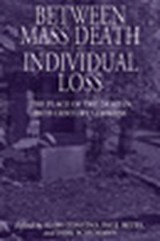Details

Between Mass Death and Individual Loss
The Place of the Dead in Twentieth-Century GermanyStudies in German History, Band 7 1. Aufl.
|
38,99 € |
|
| Verlag: | Berghahn Books |
| Format: | EPUB |
| Veröffentl.: | 01.07.2008 |
| ISBN/EAN: | 9780857450517 |
| Sprache: | englisch |
| Anzahl Seiten: | 344 |
DRM-geschütztes eBook, Sie benötigen z.B. Adobe Digital Editions und eine Adobe ID zum Lesen.
Beschreibungen
<p> Recent years have witnessed growing scholarly interest in the history of death. Increasing academic attention toward death as a historical subject in its own right is very much linked to its pre-eminent place in 20th-century history, and Germany, predictably, occupies a special place in these inquiries. This collection of essays explores how German mourning changed over the 20th century in different contexts, with a particular view to how death was linked to larger issues of social order and cultural self-understanding. It contributes to a history of death in 20th-century Germany that does not begin and end with the Third Reich.</p>
<p> <b>Introduction</b><br> <i>Paul Betts</i>, <i>Alon Confino</i>, <i>Dirk Schumann</i></p>
<p> <b>PART I: BODIES</b></p>
<p> <b>Chapter 1.</b> How the Germans Learned to Wage War. On the Question of Killing in the First and Second World Wars<br> <i>Michael Geyer</i></p>
<p> <b>Chapter 2.</b> The Shadow of Death in Germany at the End of the Second World War<br> <i>Richard Bessel</i></p>
<p> <b>Chapter 3.</b> Rebuilding and Reburying: Emergency Cemeteries in Berlin after ‘Zero Hour’<br> <i>Monica Black</i></p>
<p> <b>PART II: DISPOSAL</b></p>
<p> <b>Chapter 4.</b> Fanning the Flames – Cremation in Late Imperial and Weimar Germany<br> <i>Simone Ameskamp</i></p>
<p> <b>Chapter 5.</b> Disposing of the Dead in East Germany, 1945 – 1990<br> <i>Felix Robin Schulz</i></p>
<p> <b>Chapter 6.</b> Death in Munich. The 1972 Olympics<br> <i>Kay Schiller</i></p>
<p> <b>Chapter 7.</b> When Cold Warriors Die: The State Funerals of Konrad Adenauer and Walter Ulbricht<br> <i>Paul Betts</i></p>
<p> <b>PART III: SUBJECTIVITY</b></p>
<p> <b>Chapter 8.</b> A Common Experience of Death: Commemorating the German-Jewish Soldiers of the First World War, 1914-1923<br> <i>Tim Grady</i></p>
<p> <b>Chapter 9.</b> Laughing about death? `German Humor´ in the Two World Wars<br> <i>Martina Kessel</i></p>
<p> <b>Chapter 10.</b> Death, Spiritual Solace, and Afterlife. Between Nazism and Religion<br> <i>Alon Confino</i></p>
<p> <b>Chapter 11.</b> Yizkor! Commemoration of the Dead by Jewish Displaced Persons in Postwar Germany<br> <i>Gabriel Finder</i></p>
<p> <b>PART IV: RUINS</b></p>
<p> <b>Chapter 12.</b> The Imagination of Disaster. Death and Survival in Postwar West Germany<br> <i>Svenja Goltermann</i></p>
<p> <b>Chapter 13.</b> European Melancholy and the Inability to Listen: Sebald, Politics, and Death<br> <i>Daniel Steuer</i></p>
<p> <b>Chapter 14.</b> A Cemetery in Berlin<br> <i>Peter Fritzsche</i></p>
<p> Notes on contributors<br> Bibliography<br> Index</p>
<p> <b>PART I: BODIES</b></p>
<p> <b>Chapter 1.</b> How the Germans Learned to Wage War. On the Question of Killing in the First and Second World Wars<br> <i>Michael Geyer</i></p>
<p> <b>Chapter 2.</b> The Shadow of Death in Germany at the End of the Second World War<br> <i>Richard Bessel</i></p>
<p> <b>Chapter 3.</b> Rebuilding and Reburying: Emergency Cemeteries in Berlin after ‘Zero Hour’<br> <i>Monica Black</i></p>
<p> <b>PART II: DISPOSAL</b></p>
<p> <b>Chapter 4.</b> Fanning the Flames – Cremation in Late Imperial and Weimar Germany<br> <i>Simone Ameskamp</i></p>
<p> <b>Chapter 5.</b> Disposing of the Dead in East Germany, 1945 – 1990<br> <i>Felix Robin Schulz</i></p>
<p> <b>Chapter 6.</b> Death in Munich. The 1972 Olympics<br> <i>Kay Schiller</i></p>
<p> <b>Chapter 7.</b> When Cold Warriors Die: The State Funerals of Konrad Adenauer and Walter Ulbricht<br> <i>Paul Betts</i></p>
<p> <b>PART III: SUBJECTIVITY</b></p>
<p> <b>Chapter 8.</b> A Common Experience of Death: Commemorating the German-Jewish Soldiers of the First World War, 1914-1923<br> <i>Tim Grady</i></p>
<p> <b>Chapter 9.</b> Laughing about death? `German Humor´ in the Two World Wars<br> <i>Martina Kessel</i></p>
<p> <b>Chapter 10.</b> Death, Spiritual Solace, and Afterlife. Between Nazism and Religion<br> <i>Alon Confino</i></p>
<p> <b>Chapter 11.</b> Yizkor! Commemoration of the Dead by Jewish Displaced Persons in Postwar Germany<br> <i>Gabriel Finder</i></p>
<p> <b>PART IV: RUINS</b></p>
<p> <b>Chapter 12.</b> The Imagination of Disaster. Death and Survival in Postwar West Germany<br> <i>Svenja Goltermann</i></p>
<p> <b>Chapter 13.</b> European Melancholy and the Inability to Listen: Sebald, Politics, and Death<br> <i>Daniel Steuer</i></p>
<p> <b>Chapter 14.</b> A Cemetery in Berlin<br> <i>Peter Fritzsche</i></p>
<p> Notes on contributors<br> Bibliography<br> Index</p>
<p> <strong>Dirk Schumann</strong> is Professor of Modern and Contemporary History at Georg-August University, Göttingen. His most recent books include <a href="http://www.berghahnbooks.com/title.php?rowtag=SchumannRaising"><em>Raising Citizens in the "Century of the Child“: The United States and German Central Europe in Comparative Perspective</em></a> (Berghahn, 2010, edited), <a href="http://www.berghahnbooks.com/title.php?rowtag=SchumannPolitical"><em>Political Violence in the Weimar Republic, 1918–1933: Fight for the Streets and Fear of Civil War</em></a> (Berghahn, 2009).</p>

















